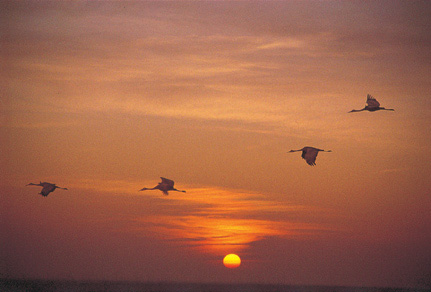
"The cranes are the greatest of the flying birds and, to my mind, the most stirring, not less so because the horn notes of their voices, like clarion calls out of the farthest skies, summon our attention to our own swift passage on this precious earth."
Magazine
Winter/Spring 2002

Photo by David Krohne
The birds of heaven
by Peter Matthiessen
On a rare clear morning—the first day of summer 1992—flying
across the Bering Strait from the Yukon delta toward the Diomede Islands
and the Chukotskiy Peninsula of Siberia, I imagine the gray sun-silvered
strait as seen from on high by a migrating crane, more particularly, by
the golden eye of the Crane from the East, as the lesser sandhill crane
of North America is known to traditional peoples on its westernmost breeding
territory in Siberia. The sandhill commonly travels a mile above the earth
and can soar higher, to at least twenty thousand feet—not astonishing
when one considers that the Eurasian and demoiselle cranes ascend to three
miles above sea level traversing the Himalaya in their north and south
migrations between Siberia and the Indian subcontinent.
That cranes may journey at such altitudes, disappearing from the sight
of the earthbound mortals, may account for their near-sacred place in
the earliest legends of the world as messengers and harbingers of highest
heaven. In Cree Indian legend, Crane carries Rabbit to the moon. Aesop
extols the crane’s singular ability “to rise above the clouds
into endless space, and survey the wonders of the heavens, as well as
of the earth beneath with its seas, lakes, and rivers, as far as the eye
can reach,” and Homer and Aristotle comment on great crane migrations.
Every land where they appear has tales and myths about the cranes, which
since ancient times have represented longevity and good fortune, harmony,
and fidelity. Heaven-bound ancients are commonly depicted riding on a
crane, or assuming the crane’s majestic form for their arrival in
the clouds of immortality.
The larger cranes, over five feet tall, with broad strong wings eight
feet in span, appear well capable of bearing aloft a wispy old-time sage.
The cranes are the greatest of the flying birds and, to my mind, the most
stirring, not less so because the horn notes of their voices, like clarion
calls out of the farthest skies, summon our attention to our own swift
passage on this precious earth. Perhaps more than any other living creatures,
they evoke the retreating wilderness, the vanishing horizons of clean
water, earth, and air upon which their species—and ours, too, though
we learn it very late—must ultimately depend for survival.
Excerpted from The Birds of Heaven by Peter Matthiessen, published 2002 by Farrar, Strauss, Giroux and used by permission. Matthiessen was a guest author at Wabash during the spring of 1997.
Return to the table of contents
